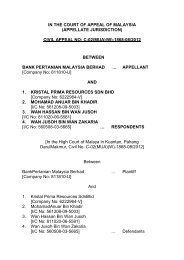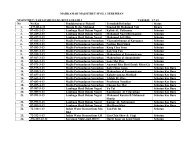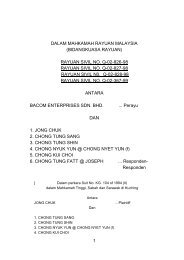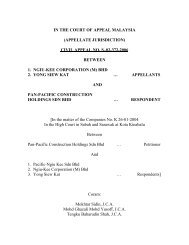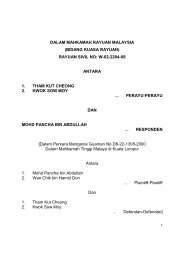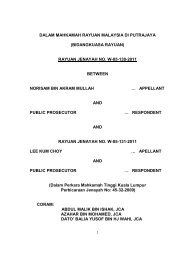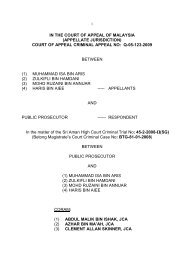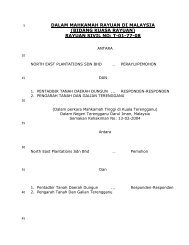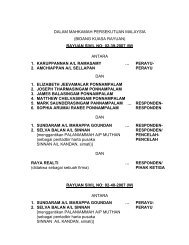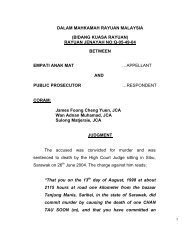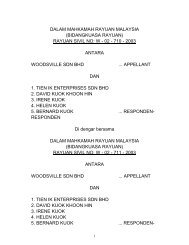THE PALACE OF JUSTICE CIVIL APPEAL NO. P-02-2074-2011 ...
THE PALACE OF JUSTICE CIVIL APPEAL NO. P-02-2074-2011 ...
THE PALACE OF JUSTICE CIVIL APPEAL NO. P-02-2074-2011 ...
You also want an ePaper? Increase the reach of your titles
YUMPU automatically turns print PDFs into web optimized ePapers that Google loves.
IN <strong>THE</strong> COURT <strong>OF</strong> <strong>APPEAL</strong> <strong>OF</strong> MALAYSIA<br />
(APPELLATE JURISDICTION)<br />
<strong>THE</strong> <strong>PALACE</strong> <strong>OF</strong> <strong>JUSTICE</strong><br />
<strong>CIVIL</strong> <strong>APPEAL</strong> <strong>NO</strong>. P-<strong>02</strong>-<strong>2074</strong>-<strong>2011</strong><br />
Appellants<br />
(1) LOH CHIAK EONG<br />
(2) LOH KEE BENG<br />
v.<br />
Respondents<br />
(1) LOK KOK BENG AND 48 O<strong>THE</strong>RS
[In the matter of the High Court of Penang<br />
Writ of Summons No. 22-130-2003<br />
Plaintiffs<br />
(1) Lok Kok Beng and 48 others<br />
v.<br />
Defendants<br />
(1) Rakyat Corporation Sdn. Bhd.<br />
(2) Loh Chiak Eong<br />
(3) Loh Kee Beng<br />
Consolidated with<br />
Writ of Summons No. 22-256-2003<br />
Plaintiff<br />
Ah Yik @ Lim Ah Yik<br />
v.<br />
2
Introduction<br />
Defendants<br />
(1) Rakyat Corporation Sdn. Bhd.<br />
(2) Loh Chiak Eong<br />
(3) Loh Kee Beng]<br />
Coram:<br />
A. Samah Nordin, JCA<br />
Mohd Hishamudin Yunus, JCA<br />
Aziah Ali, JCA<br />
JUDGMENT <strong>OF</strong> <strong>THE</strong> COURT<br />
This is an appeal against the decision of the High Court of Penang<br />
given on 27 July <strong>2011</strong>.<br />
On 5 January 2012 we, unanimously, allowed the appeal with costs.<br />
3
We now give the grounds of our decision.<br />
The facts of the case<br />
The appellants are architects by profession, and are partners in an<br />
architectural firm called ‘Loh & Loh Architects’. They are sued by the<br />
respondents for professional negligence in the carrying out of their<br />
duties as the architects of a project known as ‘Projek Skim Bangunan<br />
Industri Ringan Bersepadu Pencemaran Bebas’ at Taman<br />
Perindustrian Machang Indah (‘the project’) – a development project<br />
undertaken by a company called Merger Acceptance Sdn. Bhd (‘the<br />
developer’).<br />
The respondents are purchasers of industrial buildings or units<br />
constructed by the developer in the project. The respondents, as<br />
purchasers, each, individually, had entered into a sale and purchase<br />
agreement (‘the SPA’) with the developer.<br />
The developer, Merger Acceptance, had, by an agreement called<br />
‘Project Management Agreement’, appointed the first defendant<br />
4
(Rakyat Corporation Sdn Bhd) to be the project manager of the<br />
project.<br />
Merger Acceptance, the developer, is not a party in the action.<br />
Rakyat Corporation Sdn Bhd, whilst a party to the action before the<br />
High Court, being cited as the first defendant, however, is not a party<br />
to this appeal.<br />
In the present case, the original layout plan for the project was<br />
submitted by the appellants, as the architects of the project, to the<br />
local authority, Majlis Perbandaran Seberang Perai (‘MPSP’). It was<br />
prepared on the instruction of the developer and the project manager<br />
(the first defendant). It was subsequently submitted to MPSP on the<br />
instruction of the developer. MPSP approved the original layout plan<br />
on 20 December 1994. However, in reality, the road and drainage<br />
works were carried out not in accordance with the approved original<br />
layout plan. Instead, they were carried out in accordance with the<br />
Project Engineer’s Plan (Exh. D2A) prepared by the project engineer<br />
and approved by MPSP. But this was done not due to any oversight<br />
5
ut on purpose: out of necessity, as the original layout plan was<br />
prepared and submitted on the understanding that the developer<br />
would obtain the consents of all the neighbouring landowners that<br />
there would be some degree of encroachment into their lands (in the<br />
form of some slope cutting on their lands); but it turned out that one of<br />
the owners of the neighbouring lots (lot 495) had refused to give<br />
consent. As a result of the refusal of the owner of lot 495 to give<br />
consent to the cutting of the slopes on his land, on the advice of the<br />
project engineer (the party responsible for the design of the plan and<br />
supervision of works in the project pertaining to roads, drainage and<br />
earthworks), the original layout plan had to be amended to reflect the<br />
true road and drainage works that were carried out. The amended<br />
layout plan was submitted on 7 August 1997 and approved by MPSP<br />
on 5 August 1999.<br />
Now, going back to the SPA, Clause 7.03 of the SPA provides –<br />
Section 7.03 Vendor to procure the issue of certificate of fitness for<br />
occupation.<br />
6
The Vendor shall do all acts and things necessary to obtain the Certificate<br />
of Fitness for Occupation from the Appropriate Authorities in respect of the<br />
Industrial Building and shall at its own cost and expense comply with all<br />
the requirements of the Appropriate Authorities.<br />
The local authority, MPSP, in granting the planning approval for the<br />
project, imposed a condition that the requirements of the Department<br />
of Environment (‘DOE’), in particular, the provisions of the<br />
Environmental Quality (Industrial Effluent and Discharge) Regulations<br />
1979 must be complied with.<br />
Clause 14.<strong>02</strong> and the sixth schedule of the SPA specifically<br />
contemplate compliance with the statutory requirements of the<br />
Environmental Quality (Industrial Effluent and Discharge) Regulations<br />
1979, and for the construction of a Central Effluent Industrial<br />
Treatment System (‘the CEITS’) for the treatment of hazardous and<br />
toxic waste that will be discharged by the industries in the project.<br />
Clause 14.<strong>02</strong> of the SPA provides –<br />
Section 14.<strong>02</strong> TOXIC WASTEWATER TREATMENT<br />
7
(a) The vendor agrees to supply the relevant toxic wastewater<br />
treatment plant if so required by the purchaser and the vendor shall<br />
use its best endeavours to supply same which shall comply with the<br />
relevant existing requirements of the Department of Environment<br />
BUT ALWAYS SUBJECT to the preconditions that there is full<br />
disclosure of all the chemicals used or to be used by the purchaser<br />
together with all other information and details to be submitted in the<br />
format as set out in the Sixth Schedule herein.<br />
(b) The purchaser hereby agrees to be solely and wholly responsible<br />
and liable for any failure or shortcomings or problems whatsoever<br />
in the treatment of the wastewater as a result of inaccurate or<br />
insufficient information and details provided by the purchaser to the<br />
vendor. In such an event, the vendor shall not be liable to any party<br />
in any way whatsoever and the purchaser shall not make any<br />
claims or take any action against the vendor in respect of same.<br />
(c) The purchaser further agrees and undertakes to utilize the relevant<br />
toxic wastewater treatment plant for discharge of wastewater and<br />
chemicals in the manner following all the prescribed conditions set<br />
8
y the vendor failing which the vendor cannot be held liable for<br />
anything whatsoever.<br />
The sixth schedule to the SPA provides –<br />
SIXTH SCHEDULE<br />
In order to facilitate the effective treatment of wastewater in compliance<br />
with the requirement of the Department of Environment, the purchaser<br />
shall hereby provide true and accurate information in respect of the items<br />
specified hereafter:-<br />
(a) Nature of Industry.<br />
(b) Type of wastewater generated and the polluting agents it<br />
contained.<br />
(c) Volume of wastewater discharged/generated from your<br />
manufacturing process per hour.<br />
(d) Concentration of polluting agents (in detail).<br />
(e) Wastewater sources from manufacturing process.<br />
9
The plaintiffs, as the purchasers, had full knowledge that the<br />
construction of the CEITS was an integral part of the project.<br />
Pursuant to an application made by the developer to the DOE, the<br />
latter, by its approval letter of 12 August 1997, made it a mandatory<br />
requirement that a CEITS –<br />
(a) be designed by a specialist licensed by the DOE;<br />
(b) be built according to prescribed specifications; and<br />
(c) be functioning and operational to the satisfaction of the<br />
DOE before the application for the issuance of the<br />
Certificate of Fitness for Occupation (CFO) for the project<br />
can be made, to ensure that hazardous effluents would<br />
not be discharged into the environment.<br />
Accordingly, the developer arranged for the CEITS of the project to<br />
be designed by a specialist licensed by the DOE; and, thereafter, the<br />
10
developer proceeded to construct the CEITS. However, the CEITS<br />
that was constructed by the developer did not function according to<br />
the satisfaction of the DOE, and as a consequence the DOE refused<br />
to issue its certification of approval.<br />
By reason of the absence of the certification of approval by the DOE,<br />
the appellants, as the architects of the project, refused to apply for<br />
the CFOs notwithstanding the instruction of the developer for them to<br />
do so.<br />
Subsequently, the appellants, by reason of their refusal to follow the<br />
instruction, resigned as the architects for the project on 13 June<br />
2005. At the time of their resignation, the developer has yet to obtain<br />
the CFOs from the local authority.<br />
As a consequence, there was a delay in the application for the CFOs.<br />
The CFOs for the industrial buildings were issued only on 4 July<br />
2005. Therefore there was a delay of some 8 years before the<br />
purchasers could lawfully occupy the industrial buildings. The<br />
respondents alleged that this delay in the obtaining of the CFOs had<br />
11
caused them financial loss as they could not move in into the<br />
industrial buildings that they had purchased and to commence their<br />
business operations.<br />
The respondents allege that this delay was due to the professional<br />
negligence on the part of the appellants.<br />
At the High Court the learned High Court Judge made a peculiar<br />
finding: he found the appellants liable in negligence, but, only to the<br />
extent of 50%. However, we will say more of this peculiarity later at<br />
the end of this judgment. He ordered damages to be assessed. The<br />
learned High Court Judge made a finding that there was a breach of<br />
duty of care on the part of the appellants, as the architects of the<br />
project, by reason of –<br />
(a) being negligent in the preparation of the original layout<br />
plan such that the original layout plan had to be amended;<br />
and<br />
12
(b) the refusal on the part of the appellants, as the architects<br />
of the project, to apply for the CFOs.<br />
According to the learned Judge, the combined effect of facts (a) and<br />
(b) above resulted in a substantial delay in the obtaining of the CFOs<br />
for the industrial buildings purchased by the plaintiffs.<br />
The appellants appealed to this Court.<br />
At the trial of the action at the High Court of Penang, the appellants<br />
were the second and third defendants (therefore, in this judgment, the<br />
appellants will be referred to as the ‘defendants’); whilst the company,<br />
Rakyat Corporation Sdn. Bhd. (which we have mentioned earlier) was<br />
the first defendant.<br />
Before the trial could commence, the first defendant (Rakyat<br />
Corporation Sdn Bhd) was wound up pursuant to section 218 of the<br />
Companies Act 1965 by the Kuala Lumpur High Court (Commercial<br />
Division) via a winding-up petition presented by a company called<br />
Kumpulan GMC Enterprise Sdn Bhd. But the plaintiffs obtained leave<br />
13
of the Winding-Up Court on 13 April 2010 pursuant to section 226(3)<br />
of the Companies Act to pursue the present action against the first<br />
defendant.<br />
The first defendant and their counsel, however, were absent at the<br />
trial. They did not participate in the trial at all.<br />
At the trial before the High Court, the respondents were the plaintiffs<br />
(therefore, in this judgment, the respondents will be referred to as the<br />
‘plaintiffs’).<br />
At the outset it is to be observed that the plaintiffs are not alleging any<br />
faulty design of the industrial buildings (that they purchased from the<br />
developer) or negligent supervision on the part of the defendants, as<br />
the architects of the project, resulting in personal injury to the<br />
plaintiffs or structural defects or damage to the industrial buildings<br />
purchased by the plaintiffs.<br />
The complaints of the plaintiffs are in regard to the performance of<br />
the defendants, as architects, in the carrying out of their duties as the<br />
14
architects for the project, resulting in a long delay in the obtaining of<br />
the CFOs; and as a consequence the plaintiffs suffered financial loss.<br />
The crucial issue: Is there a duty of care owed by the defendants<br />
to the plaintiffs<br />
The essence of the plaintiffs’ claim is that the defendants owe them a<br />
duty of care to ensure that the CFOs for the industrial units<br />
purchased are obtained without undue delay.<br />
Thus, in our view, the crucial issue is this: As a matter of law, is there<br />
a duty of care owed by the defendants, as the architects of the<br />
project, to the plaintiffs, as purchasers, to ensure that the developer<br />
obtained the CFOs as stipulated under clause 7.03 of the SPA<br />
without undue delay.<br />
The present case concerns an important issue pertaining to judicial<br />
policy in the context of the law of negligence. With respect, this<br />
important judicial policy issue, unfortunately, was not properly<br />
addressed to by the learned High Court Judge in his grounds of<br />
15
judgment. This is most unfortunate as the present case concerns an<br />
extremely difficult area of law.<br />
The difficulty encountered by the courts (not only in this country but in<br />
other common law jurisdictions as well) in making any new<br />
pronouncement when confronted with a new factual situation is well<br />
stated by Lord Roskill in Caparo Industries Plc v Dickman [1990] 2<br />
AC 605 (at p. 628):<br />
I agree with your Lordships that it has now to be accepted that there is no<br />
simple formula or touchstone to which recourse can be had in order to<br />
provide in every case a ready answer to the question, given certain facts,<br />
the law will or will not impose liability for negligence or in cases where<br />
such liability can be shown to exist, determine the extent of that liability.<br />
Be that as it may, it is the submission of the learned counsel for the<br />
defendants that (1) the delay in obtaining the CFOs was not due to<br />
any want of care or diligence on the part of the defendants as the<br />
architects of the project; and (2) in any event, the defendants as the<br />
architects of the project, owe no duty of care to the plaintiffs (as<br />
purchasers of the industrial units) in relation to the obtaining of the<br />
16
CFOs under the SPA. As the learned counsel for the defendants puts<br />
it in his written submission before us –<br />
The Appellants submit that such a claim is a responsibility that has been<br />
assumed contractually by the Developer rather than the Appellants in their<br />
capacity as Architects of the Project [particularly Section 7.01 of their<br />
respective SPA].<br />
The Appellants therefore submit that it would <strong>NO</strong>T be fair, just and<br />
reasonable to impose on the Appellants a duty of care for a responsibility<br />
which they had not assumed more so when it pertains to a remedy which<br />
is already contractually provided for.<br />
For the position that he takes, the learned counsel for the defendants<br />
relies on the Singapore Court of Appeal’s decision in the case of Man<br />
B & W Diesel S E Asia Pte Ltd and another v PT Bumi<br />
International Tankers and another appeal [2004] 2 SLR (R) 300. In<br />
this case, the Court of Appeal said (at p. 318):<br />
By entering into main contract with MSE in the term which we have set<br />
out, Bumi committed itself to looking to MSE for redress. While Bumi was<br />
anxious that the sub-contractors, MBS or MBUK, should produce an<br />
17
engine in accordance with the specifications, it did not intend to seek<br />
redress from MBS or MBUK. In so far as Bumi was concerned, it had<br />
relied on MSE and MSE alone. It held MSE responsible. Even in Junior<br />
Books, Lord Roskill accepted (at 547) that the concept of proximity must<br />
always involve, at least in most cases, some degree of reliance. In such<br />
circumstances, we do not see how Bumi could have averred that it was<br />
relying on the promise of MBS and MBUK to deliver a satisfactory engine.<br />
It was not. To infer such a duty would run counter to the specific<br />
arrangement which Bumi had chosen to make with MSE. While MBS and<br />
MBUK certainly owed a duty of care to MSE by virtue of the sub-contract,<br />
we do not think a similar duty was owed to Bumi. There was no such<br />
assumption of duty by MBS or MBUK vis-à-vis Bumi. Bumi could have, by<br />
altering the contractual structure, made MBS or MBUK assume that<br />
responsibility. But it did not. Instead, Bumi elected to distance itself from<br />
all the sub-contractors, including MBS and MBUK.<br />
In this regard, we think the following passage, though obiter, of Lord Goff<br />
of Chieveley in Henderson v Merrett Syndicates Ltd [1994] 3 WLR 761<br />
at 790, is germane:<br />
I wish however to add that I strongly suspect that the situation which arises in the<br />
present case is most unusual; and that in many cases in which a contractual<br />
chain comparable to that in the present case is constructed it may well prove to<br />
be inconsistent with an assumption of responsibility which has the effect of, so to<br />
18
…<br />
speak, short circuiting the contractual structure so put in place by the parties. It<br />
cannot therefore be inferred from the present case that other sub-agents will be<br />
held directly liable to the agent’s principal in tort. Let me take the analogy of the<br />
common case of an ordinary building contract, under which main contractors<br />
contract with the building owner for the construction of the relevant building, and<br />
the main contractor sub-contracts with sub-contractors or suppliers (often<br />
nominated by the building owner) for the performance of work or the supply of<br />
materials in accordance with standards and subject to terms established in the<br />
sub-contract. I put on one side cases in which the sub-contractor causes physical<br />
damage to assumption of responsibility by the sub-contractor to the building<br />
owner; though the sub-contractor may be protected from liability by a contractual<br />
exemption clause authorized by the building owner. But if the sub-contracted<br />
work or materials do not in the result conform to the required standard, it will not<br />
ordinarily be open to the building owner to sue the sub-contractor or supplier<br />
direct under the Hedley Byrne principle, claiming damages from him on the<br />
basis that he has been negligent in relation to the performance of his functions.<br />
For there is generally no assumption of responsibility by the sub-contractor or<br />
supplier direct to the building owner, the parties having so structured their<br />
relationship that it is inconsistent with any such assumption of responsibility.<br />
This was the conclusion of the Court of Appeal in Simaan General Contracting<br />
Co v Pilkington Glass Ltd (No 2) [1988] QB 758. As Bingham LJ put it, at p<br />
781:<br />
I do not, however, see any basis on which [the nominated suppliers] could be said to have<br />
assumed a direct responsibility for the quality of the goods to [the building owners]: such a<br />
responsibility is, I think, inconsistent with the structure of the contract the parties have<br />
chosen to make.<br />
19
It is not for the court to help a party, after the event, to improve his<br />
commercial bargain. Bumi does not deserve any help. Bumi had made its<br />
bargain and must live with it. Taking the policy line advocated by Lord<br />
Denning MR in Dutton, it would not be just and reasonable in all the<br />
circumstances here to impose the duty on MBS or MBUK. There is every<br />
reason that the loss should fall on Bumi.<br />
Although the facts of our case are different from the facts of the<br />
above-quoted case, nevertheless, we find the above dicta to be of<br />
some guidance for the purpose of the present case.<br />
In our judgment, an important fact to note is that the present case is<br />
not a case of alleged carelessness on the part of the<br />
architects/defendants in the carrying out of their responsibilities as<br />
architects of the project resulting in personal injury to the plaintiffs or<br />
structural defects in the industrial buildings purchased by the plaintiffs<br />
or damage to the same.<br />
In the instant case, except for the High Court case of Steven Phoa<br />
Cheng Loon & Ors v. Highland Properties Sdn Bhd & Ors [2000]<br />
20
4 CLJ 508 (but see now the Federal Court judgment of Majlis<br />
Perbandaran Ampang Jaya v Steven Phoa Cheng Loon & Ors<br />
[2006] 2 CLJ 1), no other judicial authority was cited by the plaintiffs<br />
for their proposition that the defendants as the architects of the<br />
project owe a duty of care to the purchasers to ensure that the CFOs<br />
of the buildings were obtained without undue delay by the developer.<br />
With respect, we observe that the plaintiffs, in relying on the judgment<br />
of James Foong J (as he then was) in Steven Phoa, had failed to<br />
appreciate that that case is totally irrelevant for the purpose of the<br />
present case, as the claims in that case involved faulty design and<br />
negligent supervision on the part of the architects resulting in death<br />
and injury to persons and damage to property.<br />
At the outset it must be appreciated that in the present case the<br />
defendants, as the architects of the project, are not the agents of the<br />
plaintiffs, the purchasers. They are the agents of their employer – the<br />
developer (Merger Acceptance). In Building Contracts by Donald<br />
Keating (4 th edn.) the learned author states (at p. 200):<br />
21
The architect is engaged by the employer to act as his agent for the<br />
purpose of securing the completion of the works in an economical and<br />
efficient manner. He must perform these duties properly and if he fails to<br />
do so may be liable to the employer in damages. But in performing them<br />
he must act fairly and professionally in applying the terms of the building<br />
contract. Until recently it was thought that this gave rise to a ‘dual capacity’<br />
as agent and as quasi-arbitrator. It has now been settled by the House of<br />
Lords that an architect acting under the ordinary building contract is the<br />
employer’s agent throughout notwithstanding that in the administration of<br />
the contract he has to act in a fair and professional manner (Sutcliffe v.<br />
Thackrah [1974] A. C. 727).<br />
In our judgment, in determining whether a duty of care exists, and the<br />
scope of such duty, all relevant circumstances would have to be<br />
examined. This approach was enunciated by Gibbs CJ in The<br />
Council of the Shire of Sutherland v Heyman [1984-1985] 157<br />
CLR 424 (at p. 441):<br />
In deciding whether the necessary relationship exists, and the scope of<br />
the duty which it creates, it is necessary for the court to examine closely<br />
all the circumstances that throw light on the nature of the relationship<br />
between the parties.<br />
22
The above proposition was cited with approval by the Singapore<br />
Court of Appeal in Man B & W Diesel (see paragraph 31 of the<br />
judgment at page 312).<br />
The finding of the High Court Judge<br />
Now, in the present case, the learned High Court Judge, on the issue<br />
of liability in negligence, made a finding of mixed law and fact as<br />
follows:<br />
In my considered opinion the long delay in completing the project was<br />
caused or contributed by the 2 nd and 3 rd defendant as:<br />
(a) All the amendments (due to negligence of the defendants)<br />
took time and they affected the completion of Phase 1 of the<br />
project;<br />
(b) The completion of phase 1 of the project was delayed and<br />
the CF was only issued on 4/7/2005 because of the time<br />
taken for the approval of many amended plans and also the<br />
rectification works on works not done according to the<br />
original plans.<br />
23
(c) The amendments and rectification works might not affect the<br />
plaintiffs’ individual units, but they affected and caused the<br />
unreasonable delay in the completion of Phase 1 of the<br />
project.<br />
(d) SD3, under cross-examination also admitted that, the<br />
Architect had to amend the plans, otherwise certificate of<br />
fitness could not be obtained.<br />
The 2 nd and 3 rd defendants ought to know that when the approved plan of<br />
the authority was not complied with, amendments to this plan had to be<br />
made and that would undoubtedly delay the completion of the work in time<br />
for the CF to be issued and the delivery of vacant possession to be<br />
handed to the purchasers because approval for the amended plan would<br />
take a long time.<br />
Had the 2 nd and 3 rd defendants exercised their duty of care with diligence<br />
and competence, they would have detected or avoided or stopped the non<br />
compliance of the contractors or engineers in the construction of the road<br />
and drainage that was not according to the original approved layout plan.<br />
24
From the evidence in this case, I find that the delay which resulted in the<br />
late delivery of vacant possession of 8 years was attributed by the<br />
improper inspection and/or supervision or omission of the work at the site,<br />
to be a breach of the duty of care owed to the plaintiffs to have their unit of<br />
the industrial building purchased by them conveyed in time to hand over<br />
vacant possession with CF for their use.<br />
…<br />
Conclusion<br />
In the upshot, I agree with learned counsel for the plaintiff that the 2 nd and<br />
3 rd defendants’ conducts, actions, inactions or omission clearly fell short of<br />
standard imposed by the law on a professional Architect.<br />
With that, I allow the plaintiffs’ claim. The 2 nd and 3 rd defendants are 50%<br />
liable for the negligence.<br />
The finding of this Court<br />
With respect, we disagree with the above finding. In our judgment,<br />
while we agree that an architect may be made liable for faulty design<br />
or negligent supervision resulting in personal injury or inherent<br />
defects or damage to property, yet we know of no authority to support<br />
25
the contention made in the present case that the defendants, as the<br />
architects, owe the plaintiffs, as purchasers of the industrial buildings,<br />
a duty of care to ensure that the CFOs are obtained without undue<br />
delay. We are, however, prepared to accept the plaintiffs’ contention<br />
that the defendants, as the architects of the project, would be able to<br />
foresee that the various acts or omissions complained off, assuming<br />
for the moment that the allegations to some extent are true, would<br />
result in a delay in the obtaining the CFOs and consequential<br />
financial loss to the plaintiffs. But ‘foreseeability of harm or damage’ is<br />
not the only test or factor in determining the existence of a duty of<br />
care. In other words, as a matter of law, foreseeability of injury or<br />
damage does not automatically lead to a duty of care (see Simaan<br />
General Contracting Co v Pilkington Glass Ltd (No. 2) [1988] QB<br />
758; and Man B & W Diesel). As a matter of law, there are other<br />
considerations to be taken into account as well.<br />
It hardly needs stressing here that we are mindful of the fact that we<br />
have to tread carefully before extending the principle in Donoghue v<br />
Stevenson [1932] AC 562 to the facts of our case. For, any<br />
extension of the principle to a new situation may have far-reaching<br />
26
consequences. The case law authorities of the various common law<br />
countries have shown that extending the principle in Donoghue v<br />
Stevenson to any new situation is fraught with legal difficulties. The<br />
cases also show that any extension of the principle to a new scenario<br />
ultimately and inevitably involves an element of judicial policy. In<br />
Dutton v. Bognor Regis Urban District Council [1972] 1 QB 373<br />
Lord Denning said (at p. 397):<br />
In Rondel v Worsley [1969] 1 AC 191, we thought that if advocates were<br />
liable to be sued for negligence they would be hampered in carrying out<br />
their duties. In Dorset Yacht Co Ltd v Home Office [1970] AC 1004, we<br />
thought that the Home Office ought to pay for damage done by escaping<br />
Borstal boys, if the staff was negligent, but we confined it to damage done<br />
in the immediate vicinity. In SCM (United Kingdom) Ltd v W J Whittall<br />
[1971] 1 QB 337, some of us thought that economic loss ought not to be<br />
put on one pair of shoulders, but spread among the sufferers. In<br />
Launchbury v Morgans [1971] 2 QB 245, we thought that as the owner<br />
of the family car was insured she should bear the loss. In short, we look at<br />
the relationship of the parties; and then say, as a matter of policy, on<br />
whom the loss should fall.<br />
27
Then we have the House of Lords case of Anns v Merton London<br />
Borough Council [1978] AC 728 (HL(E)). It concerned a block of<br />
flats that had been constructed on ground that was subject to<br />
subsidence. The subsidence ultimately resulted in damage to the flats<br />
and those tenants who held long leases brought proceedings against<br />
the defendant local authority (and others) for negligently failing to<br />
inspect the foundations of the premises before approving the building<br />
works on the basis if plans that were submitted by the builders. The<br />
crucial issue in this case was whether a duty of care was owed by the<br />
local authority to the tenants. In this case there was no accident<br />
causing damage in the form of injury to person or to other property.<br />
The tenants’ loss was purely financial or monetary: the impact of the<br />
subsidence on the value of their property interest or, alternatively, the<br />
cost of repairs.<br />
In determining whether a duty of care existed, Lord Wilberforce<br />
advocated a two-stage test, the two components being foreseeability<br />
and policy:<br />
28
First one has to ask whether, as between the alleged wrongdoer and the<br />
person who has suffered damage there is a sufficient relationship of<br />
proximity or neighbourhood such that, in the reasonable contemplation of<br />
the former, carelessness on his part may be likely to cause damage to the<br />
latter – in which case a prima facie duty of care arises. Secondly, if the<br />
first question is answered affirmatively, it is necessary to consider whether<br />
there are any considerations which ought to negative, or to reduce or limit<br />
the scope of the duty or the class of person to whom it is owed or the<br />
damages to which a breach of it may give rise.<br />
The policy considerations (the second stage of the test) might include<br />
apprehension about the class of persons to whom a duty of care<br />
would be owed (as, for example, in Hedley Byrne & Company<br />
Limited v Heller & Partners Limited [1964] AC 465 (HL(E)) where<br />
concern was expressed about the number of persons who might rely<br />
on the tortfeasor’s misrepresentation); or about the nature of the loss<br />
suffered (whether purely economic or otherwise); or, about whether a<br />
private law duty of care should be recognized in a case where the<br />
parties’ relationship was governed in the public sphere by statute.<br />
Lord Wilberforce and the other members of the panel of the House of<br />
Lords, ultimately, concluded that the local authority owed a duty of<br />
care to the tenants.<br />
29
This is, indeed, a bold attempt by Lord Wilberforce’s to refine the<br />
neighbour principle to enable it to be universally applied to ever new<br />
and more far-reaching factual contexts. The two-stage test as<br />
advocated was applied by Lord Roskill subsequently in the House of<br />
Lords decision in Junior Books Ltd v Veitchi Ltd [1983] 1 AC 520.<br />
However, in 1985 the High Court of Australia declined to apply Lord<br />
Wilberforce’s two-stage test in Sutherland Shire Council v<br />
Heymann [1985] 60 ALR 1, 43. Brennan J criticized the possibilities<br />
for a ‘massive extension of a prima facie duty of care’ which Ann v<br />
Merton appeared to create. Instead, Brennan J advocated for an<br />
incrementalist approach to novel categories of negligence that were<br />
to be developed ‘by analogy with established categories’. The learned<br />
Judge said (at p. 44):<br />
I am unable to accept that approach. It is preferable, in my view, that the<br />
law should develop novel categories of negligence incrementally and by<br />
analogy with established categories, rather than by massive extension of a<br />
prima facie duty of care restrained only by indefinable ‘considerations<br />
30
which ought to negative, or to reduce or limit the scope of the duty or the<br />
class of person to whom it is owed’.<br />
And three years later, in Yuen Kun Yei v Attorney-General of Hong<br />
Kong [1988] AC 175 (PC), the Privy Council hearing an appeal from<br />
the Hong Kong Court of Appeal ruled that the two-stage test in Anns<br />
v Merton should not be regarded as in all circumstances a suitable<br />
guide in determining whether or not a duty of care was owed. In the<br />
words of the Privy Council (at p. 194):<br />
In view of the direction in which the law has since been developing, their<br />
Lordships consider that for the future it should be recognized that the two-<br />
stage test in Anns v Merton is not to be regarded as in all circumstances<br />
a suitable guide to the existence of a duty of care.<br />
Instead, according to the Privy Council, it was necessary to have<br />
regard to whether a close and direct relationship between the parties<br />
existed and this involved consideration of all the circumstances,<br />
including the reasonable contemplation of injury or damage being<br />
caused to the plaintiff by the defendant’s failure to exercise<br />
31
easonable care and any consideration of public policy that might<br />
negate the imposing of any duty of care.<br />
The above retreat from Lord Wilberforce’s approach in Anns v<br />
Merton culminated in Murphy v Brentwood District Council [1991]<br />
AC 398 in which the House of Lords overruled Anns v Merton. This<br />
case concerned a local authority’s approval of the plans for the<br />
construction of a house. The local authority had relied on the advice<br />
of a consulting engineer which had not properly taken into account<br />
miscalculations in the design of the foundations. As a result of the<br />
defective foundations there was extensive damage to the walls and<br />
pipe work of the house. The plaintiff/owner of the property did not<br />
carry out repairs, but sold the property at an undervaluation. The<br />
purchaser moved into the house and did not carry out repairs. The<br />
plaintiff’s claim was for pure economic loss, the claim being the<br />
difference between the market value and the value that the house<br />
fetched when sold. The House of Lords held that Donoghue v<br />
Stevenson applied to impose on the builder of a property a duty to<br />
exercise reasonable care and skill to avoid injury or damage through<br />
defects in its construction to those whom he might reasonably<br />
32
contemplate would be affected by his acts or omissions. However,<br />
this duty only extended to latent defects. Accordingly, where a defect<br />
was discovered before any injury to person or damage to property,<br />
other than the defective house itself, had occurred, the loss suffered<br />
by the claimant was pure economic loss and, accordingly, was<br />
irrecoverable because no duty of care was owed in respect of it. The<br />
House of Lords also held that the local authority’s duties were<br />
regulated by public law duties in the form of supervising compliance<br />
with building regulations and so forth. The extension of the local<br />
authority’s duties by the imposition, alongside public regulation, of a<br />
private law duty of care was contrary to public policy and should not<br />
be permitted; such extension was a matter for Parliament. Lord<br />
Mackay of Clashfern, the Lord Chancellor, said (at p. 457):<br />
For this House in its judicial capacity to create a large new area of<br />
responsibility on local authorities in respect of defective buildings would in<br />
my opinion not be a proper exercise of judicial power.<br />
In Governors of the Peabody Donation Fund v Sir Lindsay<br />
Parkinson & Co Ltd [1985] AC 210 at 241 Lord Keith of Kinkel<br />
33
expressed the judicial policy element in determining the existence of<br />
a duty of care in the following terms:<br />
So in determining whether or not a duty of care of particular scope was<br />
incumbent upon a defendant it is material to take into consideration<br />
whether it is just and reasonable that it should be so.<br />
In the early 1990s, there were further attempts by Judges of the<br />
House of Lords to formulate a general principle by which to determine<br />
the existence of a duty of care. For instance, in Smith v Eric S Bush<br />
[1990] 1 AC 831 (HL(E)) Lord Griffiths enunciated a test based on (i)<br />
foreseeability; (ii) proximity; and (iii) justice and reasonableness.<br />
In the House of Lords case of Caparo Industries Plc v Dickman (a<br />
case that we have mentioned earlier) Lord Bridge of Harwich<br />
summarized the principle on duty of care as follows:<br />
What emerges is that, in addition to the foreseeability of damage,<br />
necessary ingredients in any situation giving rise to a duty of care are that<br />
there should exist between the party owing the duty and the party to whom<br />
it is owed a relationship characterized by the law as one of ‘proximity’ or<br />
34
‘neighbourhood’ and that the situation should be one in which the court<br />
considers it fair, just and reasonable and that the law should impose a<br />
duty of a given scope upon the one party for the benefit of the other.<br />
In the House of Lords case of Barret v Enfield London Borough<br />
Council [2001] 2 AC 550 (HL(E)) Lord Browne-Wilkinson said:<br />
In English law the decision as to whether it is fair, just and reasonable to<br />
impose a liability in negligence on a particular class would-be defendants<br />
depends on weighing in the balance the total detriment to the public<br />
interest in all cases from holding such class liable in negligence as against<br />
the total loss to all would be plaintiffs if they are not to have a cause of<br />
action in respect of the loss they have individually suffered.<br />
Now, having gone through the case law, let us revert to the facts of<br />
the present case.<br />
In the present case, it is our judgment that, considering the facts of<br />
our case and the judicial authorities (none of which is on all fours with<br />
the facts of the present case), it would not be just and reasonable to<br />
impose a duty of care on the defendants/architects to ensure that<br />
35
there is no undue delay on the part of the developer (Merger<br />
Acceptance) in obtaining the CFOs from the local authority, MPSP.<br />
The plaintiffs, as purchasers, had entered into a contractual<br />
relationship with the developer, Merger Acceptance, and the latter is<br />
contractually obliged under clause 7.03 of the SPA to ensure that the<br />
CFO is obtained without undue delay. Therefore, should there be any<br />
undue delay in obtaining the CFO, due to some carelessness or<br />
blunder or omission on the part of the developer or its agents (the<br />
defendants, being the developer’s architects, are the agents of the<br />
developer), the plaintiffs’/purchasers’ only remedy, in our view, is to<br />
sue the developer for breach of contract or for negligence, and not to<br />
sue the defendants/architects, who have no contractual relationship<br />
with the plaintiffs/purchasers, by attempting to invoke the law of<br />
negligence. If the defendants/architects were careless or negligent in<br />
carrying out their duties resulting in a delay in the issuance of the<br />
CFO, it is to the developer that they should be answerable; and not to<br />
the plaintiffs/purchasers. The defendants/architects were not<br />
appointed by the plaintiffs/purchasers; nor were they agents of the<br />
plaintiffs/purchasers. The defendants/architects were appointed by<br />
the developer, and they were the agents of the developer. They<br />
36
certainly owe a duty of care to the developer, their employer, to<br />
ensure that there would be no undue delay in obtaining the CFOs. In<br />
our judgment, in the light of the contractual arrangements of the<br />
parties, it would not be fair to impose on the defendants a duty of<br />
care to the purchasers with regard to the obtaining of the CFOs. In<br />
our view, on the facts of the present case and, in particular, the<br />
contractual arrangements of the parties, it would be apt to adopt the<br />
following statement in the judgment of the Singapore Court of Appeal<br />
in Man B & W Diesel (at p. 321) –<br />
It is not for the court to help a party, after the event, to improve his<br />
commercial bargain.<br />
Moreover, in the present case, there is another pertinent legal<br />
consideration: we find that the damage suffered by the plaintiffs is<br />
purely financial in nature. The financial loss is not linked to any<br />
personal injury or structural defects or damage to property. None of<br />
the plaintiffs complain of any personal injury or of any structural<br />
defects or damage to his industrial building as a result of the lateness<br />
in obtaining the CFOs or as a result of the manner that the<br />
37
defendants dealt with the CFO issue. We are, of course, mindful of<br />
the High Court judgment in Dr. Abdul Hamid Abdul Rashid v<br />
Jurusan Malaysia Consultants [1997] 3 MLJ 546; but, nonetheless,<br />
we are of the view that the weight of judicial opinion are against<br />
extending the Donoghue v Stevenson principle to pure economic<br />
loss (see D & F Estates Ltd v Church Commissioners for England<br />
[1989] AC 177; Murphy v Brentwood District Council [1991] 1 AC<br />
398; Kerajaan Malaysia v Cheah Foong Chiew & Anor [1993] 2<br />
MLJ 493; Teh Khem On & Anor v Yeoh & Wu Development Sdn<br />
Bhd [1995] 2 MLJ 663). In Murphy v Brentwood Lord Keith of Kinkle<br />
said (at p. 468):<br />
The right to recover for pure economic loss, not flowing from physical<br />
injury, did not then extend beyond the situation where the loss had been<br />
sustained through reliance on negligent mis-statements, as in Hedley<br />
Byrne.<br />
In this regard, we wish to associate ourselves with the observation<br />
made by the Singapore Court of Appeal in Man B& W Diesel, that<br />
the cases in England (for instance, Junior Books Ltd v Veitchi Ltd<br />
[1983] 1 AC 520), Australia (for example, Bryan v Maloney [1995]<br />
38
128 ALR 163), New Zealand (for example, Invercargill City v<br />
Hamlin [1994] 3 NZLR 512) and Canada (for example, Winnipeg<br />
Condominium Corporation No. 36 v Bird Construction Co [1995]<br />
121 DLR (4 th ) 193), often quoted in support of the argument that there<br />
could be a finding of duty of care even in cases of supposedly ‘pure’<br />
economic losses, upon a closer examination of the facts of these<br />
cases, it will be noted that in these cases the losses were in a sense<br />
not purely economic in nature; for in these cases the economic losses<br />
were suffered on account of damage to homes. Nearer to home, even<br />
in the Singapore landmark case of RSP Architects Planners &<br />
Engineers v Ocean Front Pte Ltd [1995] 3 SLR (R) 653, where the<br />
Singapore Court of Appeal had allowed a claim for ‘economic loss’ for<br />
the tort of negligence, there in that case it will be noted that it was not<br />
a purely economic loss as the Court, among others, took into account<br />
the fact that the developers were negligent in their construction of the<br />
common property resulting in defects which the management<br />
corporation had to make good.<br />
39
Our aforesaid finding that on the factual matrix of the case the<br />
defendants owe no duty of care to the plaintiffs is sufficient for us to<br />
dispose off this appeal in favour of the appellants/defendants.<br />
There is no breach of duty of care anyway (assuming there is a<br />
duty of care owed)<br />
However, for the sake of completeness we would just like to add the<br />
following. In the instant case we find that the findings of the learned<br />
High Court Judge that the defendants were responsible for the delay<br />
in obtaining the CFOs are against the weight of the evidence. We<br />
begin with the allegation of carelessness on the part of the<br />
defendants in preparing and submitting the original layout plan to the<br />
local authority, MPSP. In this regard, we find that on the evidence the<br />
plaintiffs are making a mountain out of molehill. It is to be appreciated<br />
that even the evidence of the plaintiffs’ own witness, one Mr. Ooi<br />
Yeow Khoon (PW2), the civil and structural engineer of the project,<br />
lends support to the defendants’ evidence and contention that it was<br />
not the fault of the defendants that the original layout plan had to be<br />
amended. The defendants, in preparing the original layout plan, had<br />
had to rely on the expertise and inputs of the project engineer (PW2)<br />
40
that the layout plan necessitated encroachment into the neighbouring<br />
lands; and that PW2, in giving his inputs, in turn had relied on the<br />
assurance of the developer that they would be able to obtain the<br />
consent of all the owners of the neighbouring lots affected by the<br />
layout plan; but then, as things turned out to be, one of the owners of<br />
the neighbouring lands refused to give consent. When this particular<br />
neighbour was adamant in not giving his consent, PW2 advised the<br />
developer, the first defendant (the project manager) and the<br />
defendants (the architects) to amend the original layout plan; and the<br />
amended layout plan had to be submitted to the local authority for<br />
approval. PW2’s evidence was supported by the evidence of an<br />
independent witness, one Mr. Chew Kam Soon (DW3 - a former<br />
director of the developer, besides being a qualified engineer of 29<br />
years experience). The learned High Court Judge, in our opinion, with<br />
respect, had not given a proper evaluation of the evidence of the third<br />
defendant (architect Loh Kee Beng - DW2) as well as the evidence of<br />
PW2 and DW3 in arriving at his decision.<br />
On the evidence, the defendants also could not be faulted for refusing<br />
to apply for the CFOs (and for discharging themselves as the<br />
41
architects of the project) since the CEITS built by the developer on<br />
the advice of the specialist consultant had failed to meet the<br />
requirement of the Environmental Quality Act 1974 (‘the EQA’). It<br />
would have been a futile exercise, highly improper and inconsistent<br />
with the EQA for the defendants to apply for the CFOs when they and<br />
the developer knew fully well that the DOE had not approved the<br />
CEITS built by the developer. In this regard, the learned High Court<br />
Judge had failed to consider the evidence of Mr. Muniandy (DW1),<br />
the Chief Assistant Director of the Department of Environment, who<br />
testified that providing the CIETS was a mandatory requirement<br />
imposed by his department on the developer under the EQA as the<br />
purpose of the statutory law was to protect the health of the occupiers<br />
of the industrial buildings as well as the environment; and that the<br />
DOE would not support any application for CFO if this mandatory<br />
requirement was not complied with. DW1 further said in evidence that<br />
it would be an offence under the EQA for the purchasers to begin<br />
operation of their businesses on their premises (i.e. the industrial<br />
buildings that they have purchased) in the absence of a CIETS<br />
approved by the DOE.<br />
42
Peculiarity of High Court’s Order<br />
Finally it is disquieting for us to note from the notes of evidence, the<br />
grounds of judgment of the learned High Court Judge and the sealed<br />
Order of the High Court that the learned High Court Judge only made<br />
a finding of liability on the defendants (who are the second and third<br />
defendants before the High Court). No finding of liability (or<br />
otherwise) was made against the first defendant who was absent and<br />
did not participate in the High Court proceeding. Although there is the<br />
other defendant to the action, namely, Rakyat Corporation, the first<br />
defendant, yet the notes of evidence, the grounds of judgment of the<br />
learned Judge and the sealed Order of the High Court appear to have<br />
just ignored the existence of this other party. The notes of evidence,<br />
the grounds of judgment and the sealed Order of the High Court had<br />
merely focused on the second and third defendants.<br />
To add to this puzzle, in his notes of evidence and grounds of<br />
judgment (and confirmed by the sealed Order), the learned High<br />
Court Judge, as we have pointed out earlier, found the defendants<br />
(meaning the second and third defendants) to be only ‘50% liable’,<br />
thus implying that the second and third defendants are mere co-<br />
43
tortfeasors (there is no allegation or finding of contributory negligence<br />
on the part of the plaintiffs). Yet the reason as to why the liability<br />
against the second and third defendants has to be only ‘50%’ is,<br />
remarkably, not explained in the grounds of judgment. The reason as<br />
to why the second and third defendants are found to be mere co-<br />
tortfeasors is also, curiously, not explained in the grounds of<br />
judgment. It is also not explained in the grounds of judgment that, if<br />
the second and third defendants are mere co-tortfeasors, then who<br />
is/are the other tortfeasor/tortfeasors who is/are also 50% liable? Is it<br />
the developer (Merger Acceptance)? Or, is it the first defendant<br />
(Rakyat Corporation)? Or, is there some other party? On this<br />
question, the notes of evidence, the grounds of judgment and the<br />
sealed Order, unfortunately, appear to be silent.<br />
[Appeal allowed with costs of RM50,000 for here and below]<br />
(DATO’ MOHD HISHAMUDIN YUNUS)<br />
Judge, Court of Appeal<br />
Palace of Justice<br />
Putrajaya<br />
44
Date of decision: 5 January 2012<br />
Date of written grounds of judgment: 16 Oktober 2012<br />
Mr. Kenny Chan Kean Li, Mr. Yap Kok Kheong and Ms Ong Bee<br />
Khoon (Messrs Gibb & Co.) for the appellants<br />
Mr. Siau Suen Miin and Mr. Loo Yook Khin (Messrs Siau Suen Miin &<br />
Tan) for the respondents<br />
45



